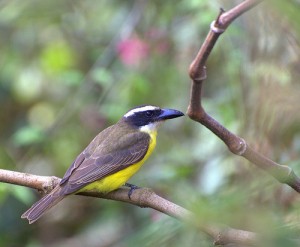Boat-billed Flycatcher Feature

I just published my first feature article for Xeno-Canto. I figured I should give their blogging functionality a try, and I’m happy with the result. My subject is geographic differences in the vocalizations of the Boat-billed Flycatcher (Megarynchus pitangua), a Central and South American species that looks much like the Great Kiskadee of south Texas.
For reasons I explained in my recent post on hybrid flycatchers, vocal differences in flycatchers are likely to represent strong genetic differences. I noticed some time ago that Boat-billed Flycatchers in Central America make some distinctive sounds that Boat-billed Flycatchers in South America don’t make, and vice versa. I thought I would be able to write a quick feature recommending a split — a la my Gray Hawk posts [1 2] — but as I started writing, I realized that Boat-billed Flycatchers make a number of different sounds, some of them geographically variable, others apparently not. It took me far longer to complete my project than I anticipated, which is one of the reasons why you’ve seen Earbirding go so long without a new post!
So head on over to Xeno-Canto’s feature page to check out my work. As always, I’d love to hear what you think!
5 thoughts on “Boat-billed Flycatcher Feature”
Hi Nathan,
I’ve got a few more cuts of the Tumbesian form I can upload to X-c shortly… I’ll also note that the photo you selected looks to me more like a Great Kiskadee… I don’t see any rufous on it (given the angle), but the bill is not particularly large or deep.
Thanks, Dan. I think you were right about the photo — I went ahead and changed it. I see you have already uploaded several Tumbesian cuts and I will have to update my feature in the morning!
Much appreciated!
Nice work. It’s useful to have something like this out there… now if only something similar were done for Social Flycatcher, Streaked Flycatcher, Golden-crowned Flycatcher, etc., etc… 😉
Dan, I updated the feature to include your cuts from Tumbes. Looks like that form is vocally distinctive as well.
Besides the birds you mentioned, which other species need this kind of vocal investigation? (South America isn’t really my bailiwick, but as time permits I’m more than happy to dig through other people’s recordings!)
Jeez, that’s a tall order… basically any species that has a large range and several named taxa would fit the bill. Southern Beardless-Tyrannulet and Olivaceous Woodcreeper are two obvious choices, but there are hundreds of others. Literally. These would each be a good dissertation topic (and perhaps someone is already delving into some of them, but most likely on the molecular end… it would be nice to have some kind of comprehensive vocal component to go along with it). Take your pick!
PS: what’s a “bailiwick”?
Comments are closed.